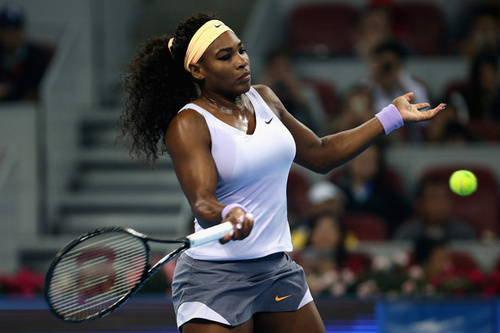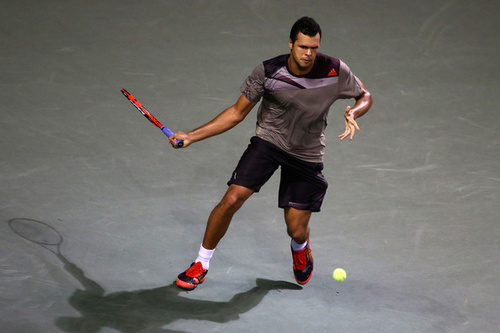Don't miss any stories → Follow Tennis View
FollowStuds and Duds: Reviewing the Best and Worst of Beijing and Tokyo
Not only a WTA Premier Mandatory event but two star-studded ATP 500 tournaments unfolded in Asia this week. The Studs and Duds series brings you the best and worst of Beijing and Tokyo, where the women concluded the last significant event of their regular season and the men prepared for a Masters 1000 tournament in Shanghai.
Studs:
Top seeds, everywhere: For the second time this year, a world No. 1 won a title while surrendering the top ranking a day later to the runner-up whom he defeated. Victoria Azarenka had defeated Serena Williams in Doha as the two women traded places at No. 1, and Novak Djokovic did the same against Rafael Nadal in Beijing. The victory over his archrival may mean as much to the Serb as holding the No. 1 ranking did. Having demolished most of his pre-final opponents with ease, Djokovic halted a three-match losing streak in that rivalry in a display of impeccable serving. He never faced a break point and lost just six total points on serve to one of the ATP’s best returners. The first man to defeat Nadal on a hard court this year, Djokovic collected his fourth title in Beijing, where the medium-speed hard courts suit his game especially well.
Collecting his third title of the year, all at the ATP 500 level, Juan Martin Del Potro will not regret taking a wildcard into Tokyo. A pair of three-setters early in the week gave way to more confident play over the weekend, including a final in which he did not drop serve. After a demoralizing first-week exit at the US Open, Del Potro needed a reassuring performance to restore his confidence. He returns to the top five for the first time since the wrist surgery that sidelined him in 2010. That ranking seems appropriate for the only active man outside the Big Four who has won a major.

For most of 2013, Serena Williams has left her competition completely in the dust. No statistic reflects that fact more sharply than her five title runs without losing a set, three at elite Premier Mandatory or Premier Five tournaments. The latest of those came in Beijing as Serena established a lead of nearly 5,000 ranking points over world No. 2 Azarenka. Characteristically, she meandered unimpressively through her first few matches before finding her groove and blasting away two top-10 opponents in Caroline Wozniacki and Agnieszka Radwanska. Serena has not lost to anyone other than Azarenka at a non-major since August 2012, a sequence of success unparalleled in her career.
Rafael Nadal: Not always at his best in Beijing, Nadal did just enough by reaching the final to begin his third tenure at world No. 1. He should finish the year there, passing Bjorn Borg for sixth all-time in weeks at the top. The computers finally confirmed what most of us already recognized by midsummer: that Nadal is currently the best player in the world. While Djokovic will have gained belief from his victory in the final, that loss will not set back his opponent for long.
Jelena Jankovic: Back in the top 10 this fall after a lengthy hiatus, this former No. 1 has played some of her most convincing tennis when it matters most. In addition to a Roland Garros quarterfinal, Jankovic has reached the semifinals or better at three Premier Mandatory or Premier Five hard-court events. Her latest highlight came with a final in Beijing, exploiting a bracket that collapsed around her. Jankovic has won 10 matches this year after losing the first set, three of them in Beijing and none more important than a semifinal comeback.
Milos Raonic: For the first time in his career, Raonic reached finals at consecutive tournaments outside North America. He defeated no opponent of note in Tokyo, where he finished runner-up for the second straight year. Yet his consistency over the last two weeks suggest that he might finish the year in the top 10. Raonic even has an outside chance to qualify for the year-end championships if his strong form continues.
Czechs: Finally finding some consistency, Petra Kvitova followed her Premier Five title in Tokyo with a Premier Mandatory semifinal in Beijing. That sequence recalled runs by Caroline Wozniacki and Agnieszka Radwanska to consecutive titles at the two East Asian tournaments. Kvitova’s effort this week included a three-set comeback against world No. 5 Li Na, the highest-ranked opponent whom she has defeated this year. Joining her in the Beijing semifinals was compatriot Tomas Berdych, also improving in consistency since the US Open. Berdych defeated the towering John Isner on a hard court for the first time in his career.
Lucie Safarova saved her best for last in 2012, playing the heroine’s role in the Fed Cup final. She may have done the same in 2013, following a Premier Five quarterfinal in Tokyo with a Premier Mandatory quarterfinal in Beijing. Few players may look forward less to the offseason than this streaky Czech.
ATP one-handed backhands: This glorious shot has faded slowly into the mists of tennis history as nearly every rising star opts for the safer, more streamlined two-handed version. Two of its most accomplished practitioners shone in Tokyo and Beijing this week, however. Nicolas Almagro reached a semifinal at the former event and Richard Gasquet the latter. While Gasquet’s performance extended his momentum from a US Open semifinal, Almagro’s result may have improved his spirits late in a disappointing season.
Sam Querrey: The post-US Open hard courts can offer opportunities to salvage something promising from an otherwise dismal season. Such may prove the case for Querrey, who followed an indoor quarterfinal in Metz with a more notable quarterfinal outdoors in Beijing. The American No. 2 upset Swiss No. 2 Stanislas Wawrinka just a month after the latter thundered to the brink of the US Open final.
Sloane Stephens: A week before in Tokyo, Stephens suffered a painful three-set loss to fellow rising star Eugenie Bouchard. She had served for the match in the second set and moved within two points of victory, so a test of her character awaited when she drew Bouchard early again in Beijing. Again winning the first set and losing the second, Stephens kept her poise to avenge the Tokyo loss against this future rival. Their meetings could move from appetizers to the main course in a few years.
Fabio Fognini: Most of his exploits have come on the clay where he feels most comfortable, and Fognini came into Beijing having lost six of his last eight matches after a sensational July. Shaking off the fatigue, the Italian regrouped to reach his first hard-court quarterfinal in over a year. And Fognini delivered quality wins to get there over Tommy Robredo and Lleyton Hewitt, two players who had reached the second week of the US Open with impressive form.
Lukas Lacko: Halted by Ryan Harrison in the final round of Tokyo qualifying, Lacko made it into the main draw anyway as a lucky loser when Michael Llodra withdrew. He seized the second chance to the fullest by reaching the quarterfinals with two victories over higher-ranked opponents. For a career-long journeyman like Lacko, those 90 ranking points and $32,000 in prize money mean a lot.

Duds:
Jo-Wilfried Tsonga: His comeback from injury had started with an encouraging finals appearance in Metz, but Tsonga took a step back this week by losing to Ivan Dodig in the second round of Tokyo. (The setback looked a bit better when Dodig reached the semifinals.) On the fringes of the Race to London, the 2011 finalist there needs to find more consistent form at upcoming events in Shanghai and Europe to qualify this year.
Victoria Azarenka: The defending champion in Beijing swatted 15 double faults in her opening-round loss to Petkovic. Azarenka has lost three straight matches on hard courts for the first time in her career, although the absence of Maria Sharapova has allowed her to retain a stranglehold on the No. 2 ranking. It will be intriguing to see whether she rebounds for the year-end championships in Istanbul, not an ideal surface for her game.
Grigor Dimitrov: Sharapova’s boyfriend has endured a three-match losing streak of his own, falling to Roberto Bautista-Agut in Beijing. Since reaching the final at Brisbane to start the season, Dimitrov has compiled just a 6-9 record on outdoor hard courts. Time remains on the 22-year-old’s side, but he has stayed so consistent in his inconsistency that one begins to wonder whether he can cure it.
Anastasia Pavlyuchenkova: An example of peaking too soon came from Pavlyuchenkova’s post-US Open swing. Reaching her fourth final of 2013 in Seoul, she played inspired tennis in nearly upsetting Agnieszka Radwanska for the title. Then she crashed out of both marquee events in Tokyo and Beijing without winning a match, allowing leads to slip away on both occasions.
Kevin Anderson: Most of the season unfolded promisingly for this lanky server, a University of Illinois graduate. Anderson reached the second week of the Australian Open and Roland Garros, while recording three ATP finals and an upset over David Ferrer. But he has faded since squandering match points in the third of those finals, losing five of his last six matches and falling to lucky loser Lukas Lacko in his Tokyo opener.
Dominika Cibulkova: Since winning the Stanford title, Slovakia’s pocket rocket has lost in the first round at five of seven tournaments. The long season may have taken its toll on a woman who hurls herself so relentlessly at every ball, expending more energy in each match than most of her peers.










